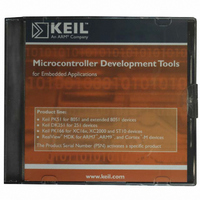MDK-ARM Keil, MDK-ARM Datasheet - Page 70

MDK-ARM
Manufacturer Part Number
MDK-ARM
Description
KIT REALVIEW MCU DEVELOPMENT
Manufacturer
Keil
Type
Compiler and IDEr
Specifications of MDK-ARM
For Use With/related Products
ARM MCUs
Lead Free Status / RoHS Status
Lead free / RoHS Compliant
- Current page: 70 of 156
- Download datasheet (3Mb)
70
Chapter 4. RL-TCPnet Introduction
User Datagram Protocol
Like the Transmission Control Protocol, the User Datagram Protocol rides within
the data packet of the Internet Protocol. Unlike TCP, UDP provides no
acknowledgement and no flow control mechanisms. UDP can be defined as a
best effort, connectionless protocol and is intended to provide a means of
transferring data between application processes with minimal overhead. It
provides no extra reliability over the Internet Protocol.
Like the Transmission Control Protocol, the User
Datagram Protocol is transported by the Internet
Protocol. Unlike TCP, UDP is a simple, low
overhead protocol that provides an easy method of
communication to a remote application.
Although delivery of data cannot be guaranteed
with UDP, its simplicity and ease of use make it the basis of many important
application protocols such as Domain Name Server (DNS) resolving and Trivial
File Transfer Protocol (TFTP).
Sockets
A socket is the combination of an IP address and a port number. In RL-TCPnet,
support is provided for the most useful TCP/IP-based applications such as web
server, using the Hypertext Transfer Protocol (HTTP) and e-mail, which is
implemented with the Simple Mail Transfer Protocol (SMTP). This means that
you do not need to control individual connections. However, if you do wish to
generate your own custom TCP or UDP frames, a low-level sockets library is
also provided. If you intend designing your own protocol you will need to decide
between UDP or TCP frames. UDP is a lightweight protocol that allows you to
send single frames. It does not provide any kind of acknowledgement from the
remote station. If you want to implement a simple control protocol that will
manage its own send and receive packets then use UDP. TCP is a more
complicated protocol that provides a logical connection between stations. This
includes acknowledgement and retransmission of messages, fragmentation of
data over multiple packets and ordering of received packets. If you need to send
large amounts of data between stations or need guaranteed delivery then use
TCP.
Related parts for MDK-ARM
Image
Part Number
Description
Manufacturer
Datasheet
Request
R

Part Number:
Description:
KIT REALVIEW MCU DEVELOPMENT
Manufacturer:
Keil
Datasheet:

Part Number:
Description:
Development Software SUPPORT EXTENSION FOR MDK-ARM-B
Manufacturer:
Keil Software

Part Number:
Description:
Development Software SUPPORT EXTENSION FOR MDK-ARM
Manufacturer:
Keil Software

Part Number:
Description:
KIT REALVIEW MCU DEVELOPMENT
Manufacturer:
Keil
Datasheet:

Part Number:
Description:
Development Software MCU DEV KIT FOR ARM UPG TO FLOATING LIC
Manufacturer:
Keil Tools

Part Number:
Description:
Development Software MCU DEV KIT FOR ARM W/ FLOATING LICENSE
Manufacturer:
Keil Software

Part Number:
Description:
Development Software MCU DEV KIT FOR ARM uVISION & C++ & RTX
Manufacturer:
Keil Tools

Part Number:
Description:
Development Software SUPP LICENSE RENEWAL 90+ DAYS NO TECH SUP
Manufacturer:
Keil Software
Part Number:
Description:
KEIL C-COMPILER INTERNATIONAL
Manufacturer:
Silicon Laboratories Inc

Part Number:
Description:
BOARD EVAL FOR LPC213X ARM MCU
Manufacturer:
NXP Semiconductors
Datasheet:
Part Number:
Description:
K60N512 Keil Tower Kit
Manufacturer:
Freescale Semiconductor
Datasheet:










